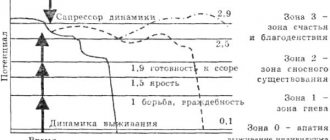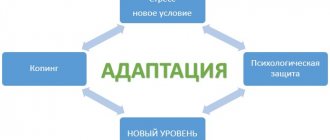Functions and types of human motives
Now let’s analyze in detail the available types of motives:
External motive . It is determined by various factors of the external world or the opinions of others. For example, if someone you know bought a new thing, and you also liked it, then motivation appears to buy the same thing for yourself.
Finished works on a similar topic
- Coursework: Types of motives in psychology 470 rub.
- Abstract Types of motives in psychology 250 rub.
- Test work Types of motives in psychology 250 rub.
Receive completed work or specialist advice on your educational project Find out the cost
Internal motive . It arises within a person, for example, there is an internal desire to go on a trip or rearrange the house.
Negative motive . Serves as a reason to protect a person from a possible mistake. For example, if I don’t do it now, then it will be too late.
Positive motive . It is built through positive examples and thought forms. An example would be this formulation: if I study a lot, then I will become the best in my group.
Sustainable motive . It is formed based on the needs of a person and does not require additional reinforcement from others.
Unstable motive . Constantly requires confirmation of his thoughts from authoritative people.
Typology of motives: what motivates people.
People's activities are stimulated not by one, but by several motives. Much depends on the driving force of each motive. Sometimes the power of one motive prevails over the influence of several motives. In most cases, the more motives are actualized, the stronger the motivation. If you manage to use additional motives, the overall level of motivation increases. Let's consider the main types of motives.
The diversity of human needs also determines the diversity of motives for behavior and activity, however, some motives are quite often updated and have a significant impact on human behavior, while others act only in certain circumstances. Let's consider the main types of motives.
Self-affirmation motive
The desire to establish oneself in society; associated with self-esteem, ambition, self-love. A person tries to prove to others that he is worth something, strives to obtain a certain status in society, wants to be respected and appreciated. Sometimes the desire for self-affirmation is referred to as prestige motivation (the desire to obtain or maintain a high social status).
Thus, the desire for self-affirmation, for increasing one’s formal and informal status, for a positive assessment of one’s personality is a significant motivational factor that encourages a person to work intensively and develop.
Motive for identification with another person
The desire to be like a hero, an idol, an authoritative figure (father, teacher, etc.) This motive encourages you to work and develop. It is especially relevant for teenagers who try to copy the behavior of other people.
The desire to be like an idol is an essential motive of behavior, under the influence of which a person develops and improves.
Identification with another person leads to an increase in the individual’s energy potential due to the symbolic “borrowing” of energy from the idol (object of identification): strength, inspiration, desire to work and act as the hero (idol, father, etc.) did. By identifying with the hero , the teenager becomes bolder.
Having a model, an idol with whom young people would strive to identify themselves and whom they would try to copy, from whom they would learn to live and work, is an important condition for an effective socialization process.
Power motive
The individual's desire to influence people. Power motivation (the need for power) is one of the most important driving forces of human action. This is the desire to take a leadership position in a group (collective), an attempt to lead people, determine and regulate their activities.
The motive of power occupies an important place in the hierarchy of motives. The actions of many people (for example, managers of various ranks) are motivated by the motive of power. The desire to dominate and lead other people is a motive that encourages them to overcome significant difficulties and make enormous efforts in the process of activity. A person works hard not for the sake of self-development or satisfaction of his cognitive needs, but in order to gain influence on individuals or a team.
A manager may be motivated to act not by the desire to benefit society as a whole or an individual team, not by a sense of responsibility, i.e. not by social motives, but by the motive of power. In this case, all his actions are aimed at gaining or maintaining power and pose a threat to both the cause and the structure that he heads.
Procedural-substantive motives
Inducement to activity by the process and content of the activity, and not by external factors. A person likes to perform this activity, to demonstrate his intellectual or physical activity. He is interested in the content of what he is doing.
The action of other social and personal motives (power, self-affirmation, etc.) can enhance motivation, but they are not directly related to the content and process of activity, but are only external to it, therefore these motives are often called external, or extrinsic. In the case of the action of procedural-substantive motives, a person likes and encourages the process and content of a certain activity to be active.
For example, a person goes in for sports because he simply likes to demonstrate his physical and intellectual activity (ingenuity and unconventional actions in sports are also significant factors for success).
An individual is encouraged to play sports by procedural-substantive motives when the process and content of the game cause satisfaction, and not by factors that are not related to sports activities (money, self-affirmation, power, etc.)
The meaning of activity during the actualization of procedural and content motives lies in the activity itself (the process and content of activity are the factor that encourages a person to show physical and intellectual activity).
Extrinsic (external) motives
This is a group of motives when the motivating factors lie outside the activity. In the case of extrinsic motives, activity is encouraged not by the content or process of the activity, but by factors that are not directly related to it (for example, prestige or material factors). Let's consider some types of extreme motives:
- motive of duty and responsibility to society, group, individuals;
- motives of self-determination and self-improvement;
- the desire to gain the approval of other people;
- the desire to obtain a high social status (prestigious motivation). In the absence of interest in the activity (procedural-content motivation), there is a desire for those external attributes that the activity can bring, for excellent grades, for obtaining a diploma, for fame in the future;
- motives for avoiding troubles and punishment (negative motivation) are motivations caused by the awareness of some troubles and inconveniences that may arise if an activity is not performed.
More on the blog: Why women cheat...
If, in the process of activity, extrinsic motives are not supported by procedural-substantive ones, i.e., interest in the content and process of the activity, then they will not provide the maximum effect. In the case of extreme motives, it is not the activity itself that is attractive, but only what is associated with it (for example, prestige, fame, material well-being), and this is often not enough to motivate activity.
Self-development motive
The desire for self-development, self-improvement. This is an important motive that encourages an individual to work hard and develop. According to A. Maslow, this is the desire to fully realize one’s abilities and the desire to feel one’s competence.
As a rule, moving forward always requires a certain amount of courage. A person often holds on to the past, to his achievements, peace and stability. Fear of risk and the threat of losing everything holds him back on the path of self-development.
Thus, a person often seems to be “torn between the desire to move forward and the desire for self-preservation and security.” On the one hand, he strives for something new, and on the other, fear of danger and something unknown, the desire to avoid risk restrains his movement forward.
Maslow argued that development occurs when the next step forward objectively brings more joy, more inner satisfaction than previous acquisitions and victories, which have become something ordinary and even boring.
Self-development and movement forward are often accompanied by intrapersonal conflict, but do not constitute violence against oneself. Moving forward is anticipation, anticipation of new pleasant sensations and impressions.
When it is possible to actualize a person’s motive for self-development, the strength of his motivation for activity increases. Talented coaches, teachers, and managers know how to use the motive of self-development, pointing out to their students (athletes, subordinates) the opportunity to develop and improve.
Achievement motive
The desire to achieve high results and mastery in activities; it manifests itself in the choice of difficult tasks and the desire to complete them. Success in any activity depends not only on abilities, skills, knowledge, but also on motivation to achieve. A person with a high level of achievement motivation, striving to obtain significant results, works persistently to achieve his goals.
Achievement motivation (and behavior that is aimed at high results) even for the same person is not always the same and depends on the situation and subject of activity. Some people choose complex problems in mathematics, while others, on the contrary, limiting themselves to modest goals in the exact sciences, choose complex topics in literature, striving to achieve high results in this area.
What determines the level of motivation in each specific activity? Scientists identify four factors:
- the importance of achieving success;
- hope for success;
- subjectively assessed probability of achieving success;
- subjective standards of achievement.
Prosocial (socially significant) motives
Motives associated with awareness of the social significance of the activity, with a sense of duty, responsibility to the group or society. In the case of prosocial (socially significant) motives, the individual identifies with the group. A person not only considers himself a member of a certain social group, not only identifies with it, but also lives by its problems, interests and goals.
A person who is driven to action by prosocial motives is characterized by normativity, loyalty to group standards, recognition and protection of group values, and the desire to realize group goals. Responsible people, as a rule, are more active and perform their professional duties more often and more conscientiously. They believe that the common cause depends on their work and efforts.
It is quite important for a manager to update the corporate spirit among his subordinates, since without identification with the group (company), namely, with its values, interests, and goals, it is impossible to achieve success.
A public figure (politician) who identifies more than others with his country and lives by its problems and interests will be more active in his activities and will do everything possible for the prosperity of the state.
Thus, prosocial motives associated with identification with the group, a sense of duty and responsibility are important in motivating a person to act. The actualization of these motives in the subject of activity can cause his activity in achieving socially significant goals.
Affiliation motive
The desire to establish or maintain relationships with other people, the desire for contact and communication with them. The essence of affiliation is the intrinsic value of communication. Affiliative communication is communication that brings satisfaction, captures, and pleases a person.
An individual, however, can also communicate because he is trying to settle his affairs and establish useful contacts with the necessary people. In this case, communication is motivated by other motives, is a means of satisfying other needs of the individual, and has nothing in common with affiliative motivation.
More on the blog: 2 types of love: Love-need and love-gift
The purpose of affiliative communication may be the search for love (or, in any case, sympathy) on the part of the communication partner.
Negative motivation
Motivations caused by the awareness of possible troubles, inconveniences, punishments that may follow in case of failure to perform an activity. For example, a schoolchild may be motivated to study by the demands and threats of his parents, or by the fear of receiving unsatisfactory grades. Studying under the influence of such a motive takes on the character of a protective action and is compulsory.
In the case of negative motivation, a person is encouraged to act by fear of possible troubles or punishment and the desire to avoid them. He reasons like this: “If I don’t do this, then trouble awaits me.” This is what drives action under the influence of negative motivation.
The forms of negative sanctions that can be applied and that can actualize negative motivation are varied:
- verbal (verbal) punishment (condemnation, reprimand, etc.);
- material sanctions (fine, deprivation of privileges, scholarships);
- social isolation (neglect, ignorance, rejection by the group, social ostracism);
- deprivation of liberty;
- physical punishment.
The main disadvantage of negative sanctions is the short duration of their influence: they stimulate activity (or deter undesirable actions) only for the period of their action.
Negative motivation has a stronger influence on a person, the greater his confidence in the inevitability of punishment.
Thus, negative motivation, including punishment, is a fairly strong motivational factor that can motivate a person to activity, but is not without many disadvantages and undesirable consequences.
Current and potential motives
Motives that occupy a leading place, are constantly updated and have a significant motivational influence on human activity are called active. Motives located at the bottom of the motivational hierarchy, which have little influence on a person’s activity and often do not appear at all, are called potential, since at a given specific period of time they do not exert a motivating influence, but can be actualized under certain circumstances.
Under the influence of certain factors, potential motives acquire motivating significance (become active motives). For example, after a conversation with a manager, a subordinate’s social motive (responsibility), which was passive (did not encourage activity), acquires greater motivating significance and becomes active.
The dynamism of the hierarchy of motives
The hierarchy of motives is not an absolutely stable motivational complex; it changes over time and age (depending on circumstances and the influence of people). For example, a subordinate is motivated to work by the manager's demands and the desire to avoid trouble. Later, this motive has less influence on his activity, and the cognitive motive may acquire leading importance.
The motivational sphere is quite dynamic: the meaning and influence of individual motives change (accordingly, the hierarchy of motives also changes). Various factors can change this hierarchy, however, despite the dynamism of the motivational sphere, each person is characterized by relative stability of the hierarchy of motives.
It can be argued that the motives that motivate us to activity are relatively stable, unchanged over a certain period of time. The relative stability of the hierarchy of motives is predetermined by the fact that the personality in general and motives in particular (but not motivation, which also depends on situational factors) are not so easily subject to change. While it is relatively easy to change or develop a child’s motivational sphere, doing this with an adult is much more difficult.
Thus, despite the influence of various factors that can change the hierarchy of motives, there is reason to consider it relatively stable.
Activity is stimulated not by one, but by several motives. The more motives determine activity, the higher the overall level of motivation. For example, when an activity is motivated by five motives, the overall level of motivation is usually higher than in the case when a person’s activity is determined by only two motives.
Much depends on the driving force of each motive. Sometimes the power of one motive prevails over the influence of several motives. In most cases, however, the more motives are actualized, the stronger the motivation. If you manage to use additional motives, the overall level of motivation increases.
Therefore, the overall level of motivation depends on:
- on the number of motives that encourage activity;
- from the actualization of situational factors;
- on the driving force of each of these motives.
Based on this pattern, a manager, in an effort to increase the motivation of his subordinates, must fulfill three conditions:
- involve (update) as many motives as possible;
- increase the motivating power of each of these motives;
- update situational motivational factors.
This pattern also applies to motivational self-regulation. When it is necessary to perform a certain activity, but there is not enough motivation, additional motives should be activated (involved) that can increase the overall level of motivation.
Author: Yuri Petrovich Platonov, Doctor of Psychology, Professor of St. Petersburg State University, Rector of the St. Petersburg State Institute of Psychology and Social Work, Honored Worker of Higher Education of the Russian Federation.
Source
Read our classified materials
Functions of motives
The main functions of human motives are as follows:
- encourage action . Search for motives and incentives that force a person to take the necessary actions;
- direct activities . Using this function, you can determine the vector and direction of actions to realize your plans;
- control and maintenance . It is carried out through behavior that is aimed at achieving the desired. By paying attention to the final goal, a person can adjust his movement, taking into account its achievements and intermediate results.
Too lazy to read?
Ask a question to the experts and get an answer within 15 minutes!
Ask a Question
Block 3. Motive. Hierarchy.
1. Motives can compete with each other, which manifests itself in the problem of choice, sometimes acute and well known to everyone. Have you ever encountered a situation where you couldn’t quickly choose which T-shirt to wear on the street? And there are situations that are more complicated, this is a choice between death and the life of one’s own, a close loved one and some group of people. This is already a class of moral dilemmas.
2. In situations of choice, the motive is determined by the value category that dominates the individual in a given period of time.
3. Motives are arranged in a hierarchical order according to the degree of importance in each specific context of a life situation. One of the motives becomes the leader, the “ CONDUCTOR ”. This entire complex process occurs against the background of constant emotional accompaniment and is not always accessible to the subject’s awareness.
4. Rationalization of motives often occurs, and a rational explanation is involved. But irrationalism can dominate behavior.
5. The leading motive is the main regulator of human activity, thus giving personal meaning to actions. However, the actions of the subject do not always “shed light” on the leading motive, and therefore premature conclusions about the opponent’s motives in negotiations often represent “guessing from the tea leaves.”
6. The so-called meaning declared by the subject can be a “screen”, “veil”, “mask” hiding the true motives. A person may not be aware of the falsity of the actualized internal meaning of an action that does not coincide with the actual motive. At the same time, be in the grip of cognitive delusions. Giving internal meaning to something is a way to explain to yourself and others the reasons for your behavior. This is a way to bring rationality into your own actions.
7. A subject who is aware of his own hierarchy of motives in various contextual situations controls motives and is able to shift “leaders”, opening the way for those motives that correlate with the main value expectations of a person, forming a deep personal and transpersonal meaning.
Motives encourage meaning-supporting and meaning-forming activities.
Block 5. Motive. Scientific experiment.
In an experiment with a laboratory rat, the pleasure center was discovered in 1954 by James Olds and Peter Milner in the limbic system.
(Olds J., Milner P., Positive reinforcement produced by electrical stimulation of the septal area and other regions of the rat brain, "Journal of Comparative and Physiological Psychology", 1954, Vol. 47, pp. 419–427.)
The rats pressed a pedal connected to a mechanism that closed the current in electrodes implanted in the brain. As a result, the rat refused food, sleep, sex and constantly, every second, pressed the pedal, bringing itself to exhaustion, exhaustion, convulsions, but without parting with the pedal. The experimenters had to literally save the lives of the rats by interrupting the flow of current to the electrodes. And only after the stimulation stopped, the rat had difficulty returning to its normal life activities. At the same time, there are centers of displeasure in the hypothalamus, when irritated, the rats jumped away sharply and categorically did not approach the “bad” pedal.











